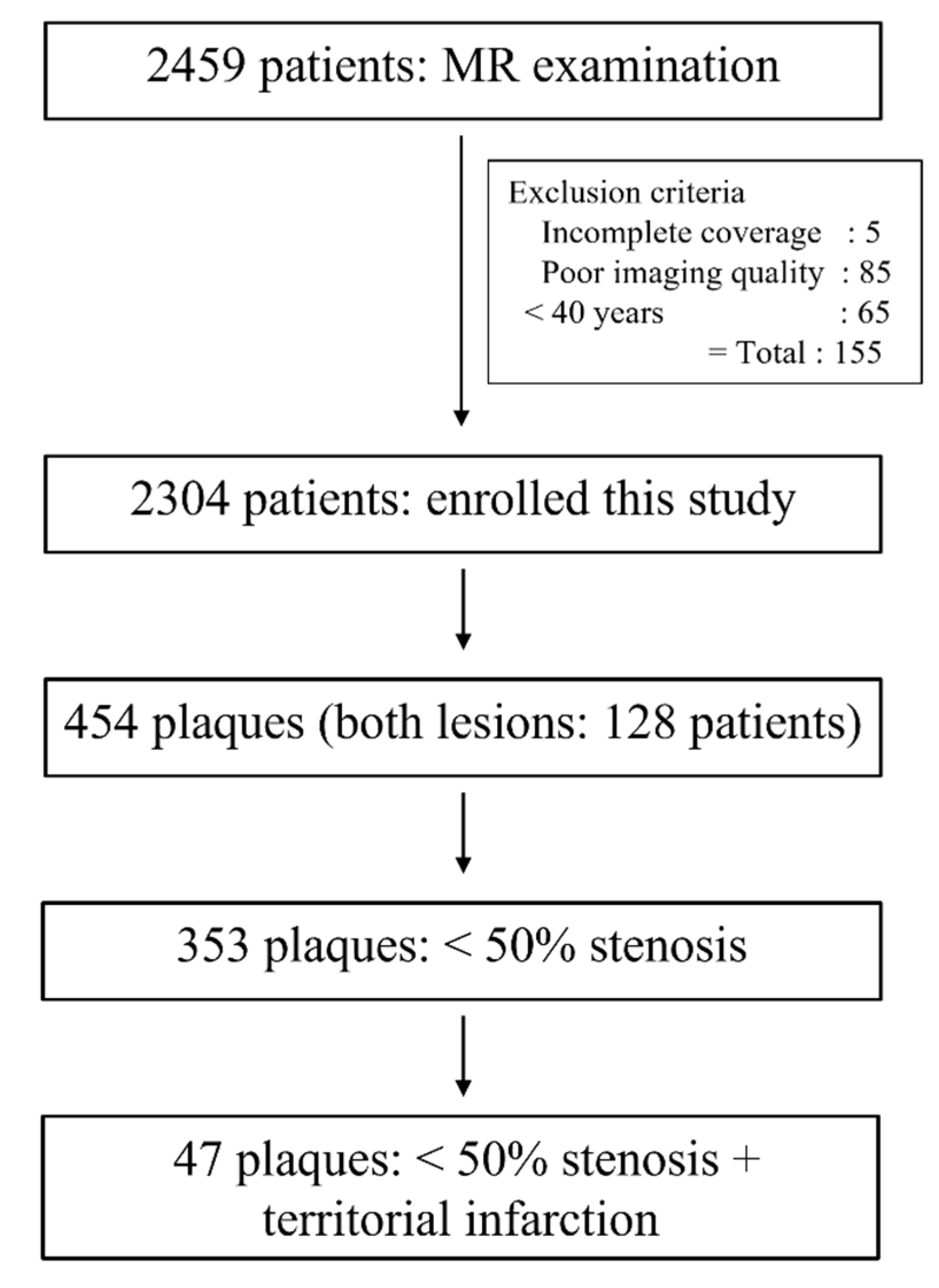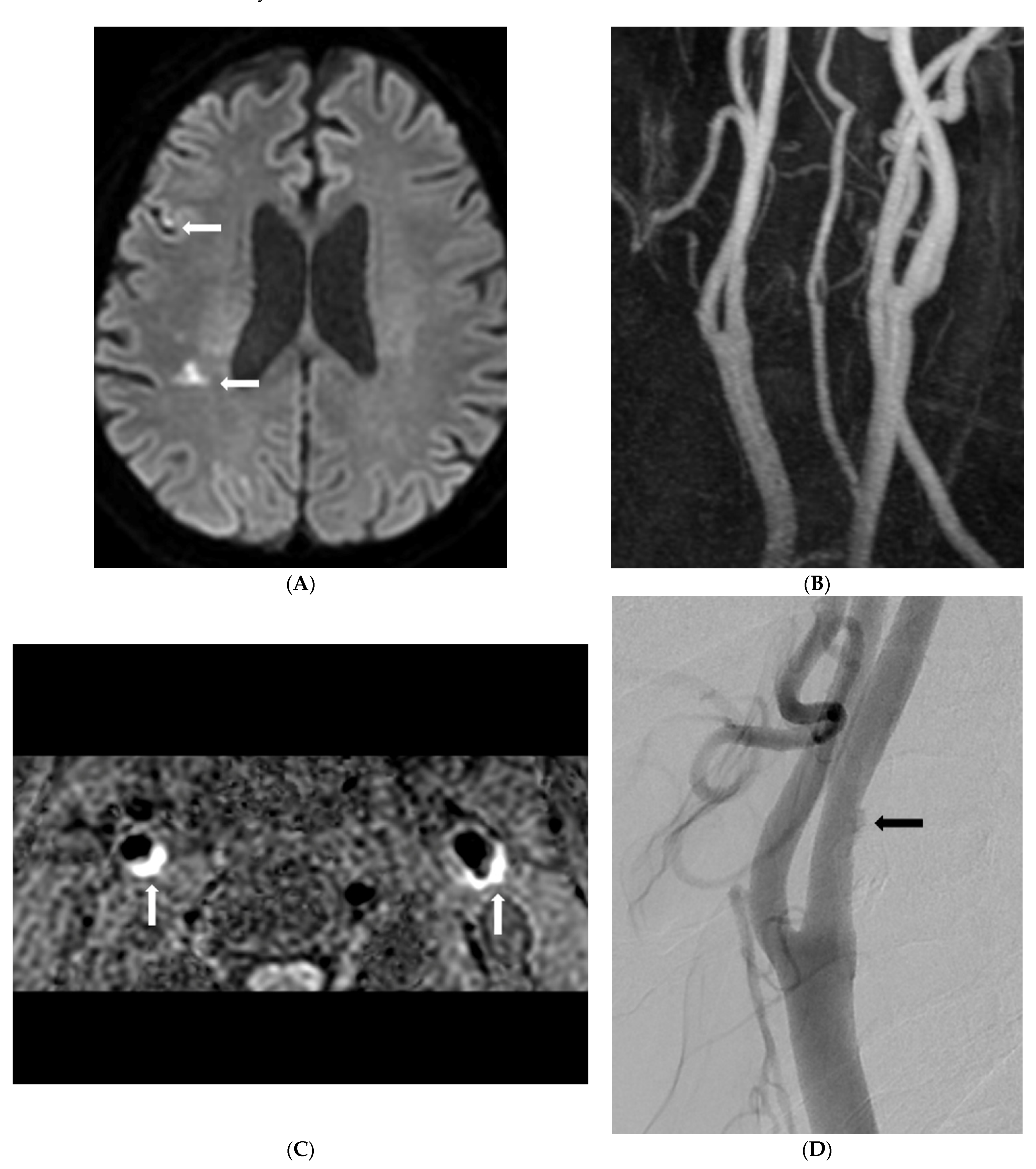Prevalence of Symptomatic Nonstenotic Carotid Disease Using Simultaneous Non-Contrast Angiography and Intraplaque Hemorrhage Imaging for MR Screen Protocol
Abstract
1. Introduction
2. Materials and Methods
2.1. Patients
2.2. MR Imaging Protocol
2.3. Clinical Data Assessment
2.4. MR Imaging Analysis
2.5. Statistical Analysis
3. Results
4. Discussion
5. Conclusions
Author Contributions
Funding
Institutional Review Board Statement
Informed Consent Statement
Data Availability Statement
Conflicts of Interest
References
- Goyal, M.; Singh, N.; Marko, M.; Hill, M.D.; Menon, B.K.; Demchuk, A.; Coutts, S.B.; Almekhlafi, M.A.; Ospel, J.M. Embolic Stroke of Undetermined Source and Symptomatic Nonstenotic Carotid Disease. Stroke 2020, 51, 1321–1325. [Google Scholar] [CrossRef] [PubMed]
- Brott, T.G.; Halperin, J.L.; Abbara, S.; Bacharach, J.M.; Barr, J.D.; Bush, R.L.; Cates, C.U.; Creager, M.A.; Fowler, S.B.; Friday, G.; et al. 2011 ASA/ACCF/AHA/AANN/AANS/ACR/ASNR/CNS/SAIP/SCAI/SIR/SNIS/SVM/SVS guideline on the management of patients with extracranial carotid and vertebral artery disease: Executive summary: A report of the American College of Cardiology Foundation/American Heart Association Task Force on Practice Guidelines, and the American Stroke Association, American Association of Neuroscience Nurses, American Association of Neurological Surgeons, American College of Radiology, American Society of Neuroradiology, Congress of Neurological Surgeons, Society of Atherosclerosis Imaging and Prevention, Society for Cardiovascular Angiography and Interventions, Society of Interventional Radiology, Society of NeuroInterventional Surgery, Society for Vascular Medicine, and Society for Vascular Surgery. J. Am. Coll. Cardiol. 2011, 57, 1002–1044. [Google Scholar] [PubMed]
- Hart, R.G.; Catanese, L.; Perera, K.S.; Ntaios, G.; Connolly, S.J. Embolic Stroke of Undetermined Source: A Systematic Review and Clinical Update. Stroke 2017, 48, 867–872. [Google Scholar] [CrossRef]
- Grosse, G.M.; Sieweke, J.T.; Biber, S.; Ziegler, N.L.; Gabriel, M.M.; Schuppner, R.; Worthmann, H.; Bavendiek, U.; Weissenborn, K. Nonstenotic Carotid Plaque in Embolic Stroke of Undetermined Source: Interplay of Arterial and Atrial Disease. Stroke 2020, 51, 3737–3741. [Google Scholar] [CrossRef] [PubMed]
- Mark, I.T.; Nasr, D.M.; Huston, J.; de Maria, L.; de Sanctis, P.; Lehman, V.T.; Rabinstein, A.A.; Saba, L.; Brinjikji, W. Embolic Stroke of Undetermined Source and Carotid Intraplaque Hemorrhage on MRI: A Systemic Review and Meta-Analysis. Clin. Neuroradiol. 2021, 31, 307–313. [Google Scholar] [CrossRef]
- Schindler, A.; Schinner, R.; Altaf, N.; Hosseini, A.A.; Simpson, R.J.; Esposito-Bauer, L.; Singh, N.; Kwee, R.M.; Kurosaki, Y.; Yamagata, S.; et al. Prediction of Stroke Risk by Detection of Hemorrhage in Carotid Plaques: Meta-Analysis of Individual Patient Data. JACC Cardiovasc. Imaging 2020, 13, 395–406. [Google Scholar] [CrossRef]
- Wang, J.; Börnert, P.; Zhao, H.; Hippe, D.; Zhao, X.; Balu, N.; Ferguson, M.S.; Hatsukami, T.S.; Xu, J.; Yuan, C.; et al. Simultaneous noncontrast angiography and intraplaque hemorrhage (SNAP) imaging for carotid atherosclerotic disease evaluation. Magn. Reson. Med. 2013, 69, 337–345. [Google Scholar] [CrossRef] [PubMed]
- Coutinho, J.M.; Derkatch, S.; Potvin, A.R.; Tomlinson, G.; Kiehl, T.-R.; Silver, F.; Mandell, D.M. Nonstenotic carotid plaque on CT angiography in patients with cryptogenic stroke. Neurology 2016, 87, 665–672. [Google Scholar] [CrossRef]
- Hart, R.G.; Diener, H.C.; Coutts, S.B.; Easton, J.D.; Granger, C.B.; O’Donnell, M.J.; Sacco, R.L.; Connolly, S.J. Cryptogenic Stroke/ESUS International Working Group. Embolic strokes of undetermined source: The case for a new clinical construct. Lancet Neurol. 2014, 13, 429–438. [Google Scholar] [CrossRef]
- Barnett, H.J.M.; Taylor, D.W.; Haynes, R.B.; Sackett, D.L.; Peerless, S.J.; Ferguson, G.G.; Fox, A.J.; Rankin, R.N.; Hachinski, V.C.; Wiebers, D.O.; et al. Beneficial effect of carotid endarterectomy in symptomatic patients with high-grade carotid stenosis. N. Engl. J. Med. 1991, 325, 445–453. [Google Scholar]
- Brott, T.G.; Halperin, J.L.; Abbara, S.; Bacharach, J.M.; Barr, J.D.; Bush, R.L.; Cates, C.U.; Creager, M.A.; Fowler, S.B.; Friday, G.; et al. 2011 ASA/ACCF/AHA/AANN/AANS/ACR/ASNR/CNS/SAIP/SCAI/SIR/SNIS/SVM/SVS guideline on the management of patients with extracranial carotid and vertebral artery disease: Executive summary: A report of the American College of Cardiology Foundation/American Heart Association Task Force on Practice Guidelines, and the American Stroke Association, American Association of Neuroscience Nurses, American Association of Neurological Surgeons, American College of Radiology, American Society of Neuroradiology, Congress of Neurological Surgeons, Society of Atherosclerosis Imaging and Prevention, Society for Cardiovascular Angiography and Interventions, Society of Interventional Radiology, Society of NeuroInterventional Surgery, Society for Vascular Medicine, and Society for Vascular Surgery. Developed in collaboration with the American Academy of Neurology and Society of Cardiovascular Computed Tomography. Catheter. Cardiovasc. Interv. 2013, 81, E76–E123. [Google Scholar] [PubMed]
- Singh, N.; Marko, M.; Ospel, J.; Goyal, M.; Almekhlafi, M. The Risk of Stroke and TIA in Nonstenotic Carotid Plaques: A Systematic Review and Meta-Analysis. AJNR Am. J. Neuroradiol. 2020, 41, 1453–1459. [Google Scholar] [CrossRef] [PubMed]
- Carpenter, K.; Murtagh, R.; Lilienfeld, H.; Weber, J.; Murtagh, F. Ipilimumab-induced hypophysitis: MR imaging findings. AJNR Am. J. Neuroradiol. 2009, 30, 1751–1753. [Google Scholar] [CrossRef] [PubMed]
- Ntaios, G.; Perlepe, K.; Lambrou, D.; Sirimarco, G.; Strambo, D.; Eskandari, A.; Karagkiozi, E.; Vemmou, A.; Koroboki, E.; Manios, E.; et al. Prevalence and Overlap of Potential Embolic Sources in Patients with Embolic Stroke of Undetermined Source. J. Am. Heart Assoc. 2019, 8, e012858. [Google Scholar] [CrossRef]
- Bulwa, Z.; Gupta, A. Embolic stroke of undetermined source: The role of the nonstenotic carotid plaque. J. Neurol. Sci. 2017, 382, 49–52. [Google Scholar] [CrossRef]
- Kamtchum-Tatuene, J.; Wilman, A.; Saqqur, M.; Shuaib, A.; Jickling, G.C. Carotid Plaque with High-Risk Features in Embolic Stroke of Undetermined Source: Systematic Review and Meta-Analysis. Stroke 2020, 51, 311–314. [Google Scholar] [CrossRef]
- Ntaios, G.; Swaminathan, B.; Berkowitz, S.D.; Gagliardi, R.J.; Lang, W.; Siegler, J.E.; Lavados, P.; Mundl, H.; Bornstein, N.; Meseguer, E.; et al. Efficacy and Safety of Rivaroxaban Versus Aspirin in Embolic Stroke of Undetermined Source and Carotid Atherosclerosis. Stroke 2019, 50, 2477–2485. [Google Scholar] [CrossRef]
- Kasner, S.E.; Swaminathan, B.; Lavados, P.; Sharma, M.; Muir, K.; Veltkamp, R.; Ameriso, S.F.; Endres, M.; Lutsep, H.; Messé, S.R.; et al. Rivaroxaban or aspirin for patent foramen ovale and embolic stroke of undetermined source: A prespecified subgroup analysis from the NAVIGATE ESUS trial. Lancet Neurol. 2018, 17, 1053–1060. [Google Scholar] [CrossRef]
- Yuan, K.; Kasner, S.E. Patent foramen ovale and cryptogenic stroke: Diagnosis and updates in secondary stroke prevention. Stroke Vasc. Neurol. 2018, 3, 84–91. [Google Scholar] [CrossRef]
- Bang, O.Y.; Ovbiagele, B.; Kim, J.S. Evaluation of cryptogenic stroke with advanced diagnostic techniques. Stroke 2014, 45, 1186–1194. [Google Scholar] [CrossRef]
- Howard, V.J.; Madsen, T.E.; Kleindorfer, D.O.; Judd, S.E.; Rhodes, J.D.; Soliman, E.Z.; Kissela, B.M.; Safford, M.M.; Moy, C.S.; McClure, L.A.; et al. Sex and Race Differences in the Association of Incident Ischemic Stroke with Risk Factors. JAMA Neurol. 2019, 76, 179–186. [Google Scholar] [CrossRef] [PubMed]
- Johnson, A.E.; Magnani, J.W. Race and Stroke Risk in Atrial Fibrillation: The Limitations of a Social Construct. J. Am. Coll. Cardiol. 2017, 69, 906–907. [Google Scholar] [CrossRef] [PubMed]
- Park, J.S.; Kwak, H.S.; Lee, J.M.; Koh, E.J.; Chung, G.H.; Hwang, S.B. Association of carotid intraplaque hemorrhage and territorial acute infarction in patients with acute neurological symptoms using carotid magnetization-prepared rapid acquisition with gradient-echo. J. Korean Neurosurg. Soc. 2015, 57, 94–99. [Google Scholar] [CrossRef]
- Altaf, N.; MacSweeney, S.T.; Gladman, J.; Auer, D.P. Carotid Intraplaque Hemorrhage Predicts Recurrent Symptoms in Patients With High-Grade Carotid Stenosis. Stroke 2007, 38, 1633–1635. [Google Scholar] [CrossRef] [PubMed]
- Porambo, M.E.; DeMarco, J.K. MR imaging of vulnerable carotid plaque. Cardiovasc. Diagn. Ther. 2020, 10, 1019–1031. [Google Scholar] [CrossRef] [PubMed]
- Knight-Greenfield, A.; Nario, J.J.Q.; Vora, A.; Baradaran, H.; Merkler, A.; Navi, B.B.; Kamel, H.; Gupta, A. Associations Between Features of Nonstenosing Carotid Plaque on Computed Tomographic Angiography and Ischemic Stroke Subtypes. J. Am. Heart Assoc. 2019, 8, e014818. [Google Scholar] [CrossRef] [PubMed]
- Zhao, X.; Hippe, D.S.; Li, R.; Canton, G.M.; Sui, B.; Song, Y.; Li, F.; Xue, Y.; Sun, J.; Yamada, K.; et al. Prevalence and Characteristics of Carotid Artery High-Risk Atherosclerotic Plaques in Chinese Patients with Cerebrovascular Symptoms: A Chinese Atherosclerosis Risk Evaluation II Study. J. Am. Heart Assoc. 2017, 6, e005831. [Google Scholar] [CrossRef]
- Glagov, S.; Weisenberg, E.; Zarins, C.K.; Stankunavicius, R.; Kolettis, G.J. Compensatory enlargement of human atherosclerotic coronary arteries. N. Engl. J. Med. 1987, 316, 1371–1375. [Google Scholar] [CrossRef]



| SyNC (n = 17) | Non-SyNC (n = 30) | p | |
|---|---|---|---|
| Age, mean ± SD | 74.5 ± 5.8 | 74.3 ± 10.0 | 0.933 |
| Males, n (%) | 13 (76.5) | 17 (56.7) | 0.175 |
| Right plaques, n (%) | 10 (58.8) | 14 (46.7) | 0.423 |
| Hypertension, n (%) | 7 (41.2) | 19 (63.3) | 0.142 |
| Diabetes, n (%) | 4 (23.5) | 13 (43.3) | 0.175 |
| Hyperlipidemia, n (%) | 5 (29.4) | 7 (23.3) | 0.733 |
| Smoking, n (%) | 8 (47.1) | 8 (26.7) | 0.156 |
| Previous stroke, n (%) | 1 (5.9) | 10 (33.3) | 0.039 |
| Atrial fibrillation, n (%) | 0 (0.0) | 2 (6.7) | 0.281 |
| Alcohol, n (%) | 4 (23.5) | 3 (10.0) | 0.235 |
| SyNC (n = 17) | Non-SyNC (n = 30) | p | |
|---|---|---|---|
| Carotid IPH, n (%) | 15 (88.2) | 15 (50.0) | 0.009 |
| Carotid stenosis, median (IQR) | 25 (10–40) | 9.5 (0–25) | 0.042 |
| Maximal wall thickness, mean ± SD | 4.5 ± 0.9 | 3.6 ± 0.8 | 0.001 |
| Crude OR | 95% CIs | p Value | Adjusted OR | 95% CI | p Value | |
|---|---|---|---|---|---|---|
| Sex | 2.485 | 0.655–9.427 | 0.181 | |||
| Hypertension | 2.468 | 0.730–8.344 | 0.146 | |||
| Diabetes | 2.485 | 0.655–9.427 | 0.181 | |||
| Smoking | 0.409 | 0.117–1.428 | 0.161 | |||
| Previous stroke | 8.0 | 0.925–69.218 | 0.059 | 15.19 | 0.974–0.978 | 0.052 |
| Carotid IPH | 0.133 | 0.026–0.687 | 0.016 | 0.081 | 0.01–0.672 | 0.02 |
| Maximal wall thickness | 0.229 | 0.084–0.624 | 0.004 | 0.183 | 0.034–0.978 | 0.047 |
| Carotid stenosis | 0.961 | 0.924–0.998 | 0.041 |
Publisher’s Note: MDPI stays neutral with regard to jurisdictional claims in published maps and institutional affiliations. |
© 2022 by the authors. Licensee MDPI, Basel, Switzerland. This article is an open access article distributed under the terms and conditions of the Creative Commons Attribution (CC BY) license (https://creativecommons.org/licenses/by/4.0/).
Share and Cite
Lee, C.R.; Yang, J.C.; Lee, U.Y.; Hwang, S.B.; Chung, G.H.; Kwak, H.S. Prevalence of Symptomatic Nonstenotic Carotid Disease Using Simultaneous Non-Contrast Angiography and Intraplaque Hemorrhage Imaging for MR Screen Protocol. Diagnostics 2022, 12, 2321. https://doi.org/10.3390/diagnostics12102321
Lee CR, Yang JC, Lee UY, Hwang SB, Chung GH, Kwak HS. Prevalence of Symptomatic Nonstenotic Carotid Disease Using Simultaneous Non-Contrast Angiography and Intraplaque Hemorrhage Imaging for MR Screen Protocol. Diagnostics. 2022; 12(10):2321. https://doi.org/10.3390/diagnostics12102321
Chicago/Turabian StyleLee, Chae Rin, Jun Cheol Yang, Ui Yun Lee, Seung Bae Hwang, Gyung Ho Chung, and Hyo Sung Kwak. 2022. "Prevalence of Symptomatic Nonstenotic Carotid Disease Using Simultaneous Non-Contrast Angiography and Intraplaque Hemorrhage Imaging for MR Screen Protocol" Diagnostics 12, no. 10: 2321. https://doi.org/10.3390/diagnostics12102321
APA StyleLee, C. R., Yang, J. C., Lee, U. Y., Hwang, S. B., Chung, G. H., & Kwak, H. S. (2022). Prevalence of Symptomatic Nonstenotic Carotid Disease Using Simultaneous Non-Contrast Angiography and Intraplaque Hemorrhage Imaging for MR Screen Protocol. Diagnostics, 12(10), 2321. https://doi.org/10.3390/diagnostics12102321






